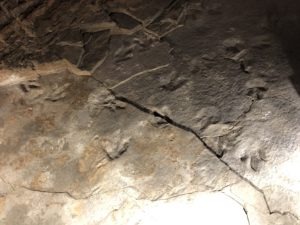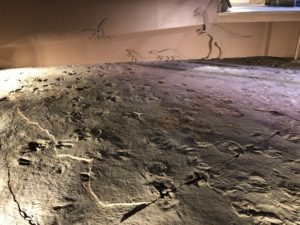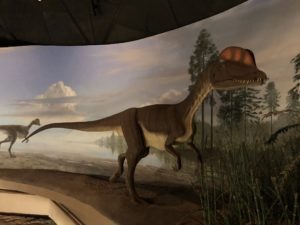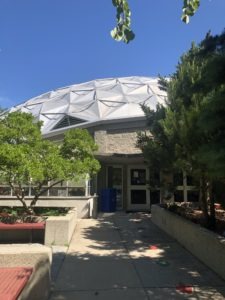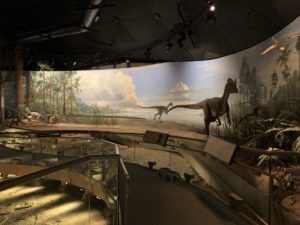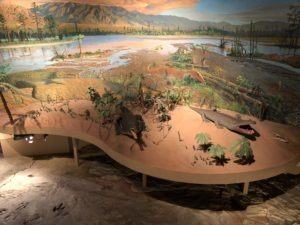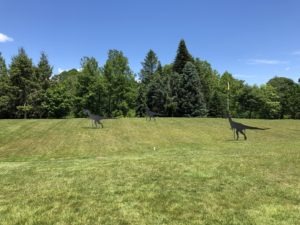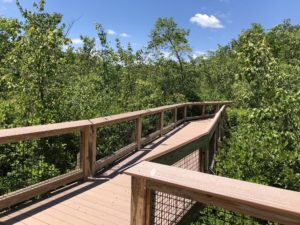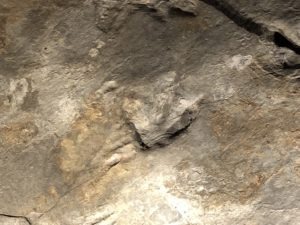On August 23, 1966, an amazing discovery was made quite by chance in the town of Rocky Hill, CT. During excavation for a state construction project, a bulldozer operator noticed some large, three-toed footprints in a slab of sandstone. It turned out that a prehistoric lakebed had been unearthed. It would ultimately yield over 2,000 fossilized tracks that were made by dinosaurs roaming the area 200 million years ago! This find would spark the beginning of what is now Dinosaur State Park.
The construction project was intended to be for a highway department testing laboratory. All this changed, however, when bulldozer operator Edward McCarthy found those prints. He notified both the project engineer as well as the lab architect. They then contacted the Peabody Museum, the University of Connecticut, and the press. Scientists evaluated the find and worked with the State. It was then decided that the site should be preserved for the benefit of the public. In September of that same year, the governor declared the area a state park.
The majority of the tracks found are known as Eubrontes. (This is the name of the track type, rather than the animal.) These footprints are 10 to 16 inches long and 10 to 12 inches wide. They date back to the Jurassic Period and were likely left by a carnivorous dinosaur known as Dilophosaurus. These creatures could be between 18 and 20 feet in length.
Eventually a geodesic dome was built over 500 of the tracks to protect them and serve as a museum. Today, visitors are able to stand on a walkway directly overlooking the myriad of fossilized footprints. There are large murals on the walls showing prehistoric landscapes and some life size dinosaur models that help bring the past to life. The museum also has a number of related exhibits and presentations. There are even a few small animals. Outdoors, visitors can enjoy walking trails that feature plant life reminiscent of the distant past. Under a field of grass next to the dome lie the other 1500 tracks, which were reburied to preserve them for the future.
I think it’s interesting to note that humans have been encountering fossilized tracks throughout history and there have been various folkloric and spiritual interpretations. Here are just a few examples:
- A traditional Iroquois tale recorded in the 19th century talks about a large mosquito monster that once terrorized the populace. It was eventually slain and its blood released many small mosquitos. Large, bird-like footprints located in Syracuse, NY were believed to have been left by that monster when it landed to rest.
- In 1802, a boy named Pliny Moody found five birdlike prints while plowing on his family’s farm in South Hadley, MA. Either a local doctor or Pliny himself started referring to the find as “the tracks of Noah’s raven.” This is a reference to the biblical story where Noah releases a raven to see if the floodwater had receded. It’s unclear whether the reference was made in jest, but some local people may have believed it.
- In Chabu, Inner Mongolia, farmers encountered three-toed tracks in the 1950s. They believed a sacred bird had left the prints symbolizing wishes for happiness.
After viewing fossil tracks myself, I certainly appreciate their mysterious and captivating nature.
Getting to Dinosaur State Park was very straightforward and there’s a parking lot on site. While it is free to walk the trails and grounds, you will need to purchase a ticket to enter the Exhibit Center. (When I visited, I felt the ticket price was very reasonable and well worth it.) Please refer to their official website for hours, ticket prices, etc.
I very much enjoyed my visit to Dinosaur State Park. It was fascinating to see fossil evidence of dinosaur activity in the exact spot in which it happened. I felt as if I was looking through a window into prehistoric times. It was certainly a fun and unique experience!
Location
400 West Street
Rocky Hill, CT 06067
Official site: dinosaurstatepark.org
Sources
Beauchamp, William Martin. Iroquois Folk Lore: Gathered from the Six Nations of New York. Syracuse, NY: Dehler Press, 1922. https://archive.org/details/iroquoisfolklore00beauuoft/.
Black, Riley. “China’s Dinosaur Folklore.” Smithsonian Magazine. January 4, 2012. https://www.smithsonianmag.com/science-nature/chinas-dinosaur-folklore-15081139/.
Cusick, David. David Cusick’s Sketches of Ancient History of the Six Nations. Lockport, NY: Turner & McCollum, 1848. https://archive.org/details/davidcusickssket00cusi/.
Filipov, David. “On the trail of a predator, 200 million years later.” The Boston Globe. March 14, 2010. http://archive.boston.com/travel/explorene/connecticut/articles/2010/03/14/on_the_trail_of_a_predator_200_million_years_later/?page=2.
Hamilton, Jason. “History of the Connecticut Valley Dinosaur Tracks.” ScienceViews.com. https://scienceviews.com/dinosaurs/connecticutvalleyhistory.html.
“History of Dinosaur State Park.” Dinosaur State Park. The Friends of Dinosaur Park and Arboretum, Inc. 2015. https://www.dinosaurstatepark.org/parkhistory.html.
“Noah’s Raven: Chapter 1: The Moody’s Doorstep.” Impressions from a Lost World. Pocumtuck Valley Memorial Association. 2017. https://dinotracksdiscovery.org/stories/noahs-raven/1/.
State Geological and Natural History Survey of Connecticut. Thirty-Second Biennial Report of the Commissioners of the State Geological and Natural History Survey 1965 – 1967. Bulletin 100 (1967). https://portal.ct.gov/-/media/DEEP/geology/archives/BiennialReports/CGNHSBull100pdf.pdf.
Written by A. P. Sylvia

